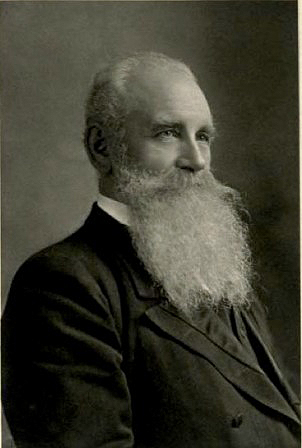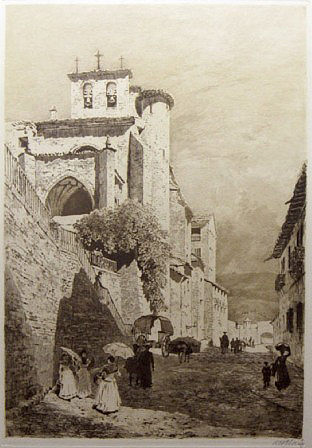The piece of the month of April 2015
"PAMPELUNA: RETURNING FROM THE FAIR" AND "A HILL TOWN IN NAVARRE", TWO ENGRAVINGS BY AXEL HERMAN HEIG ABOUT PAMPLONA
Pilar Andueza Unanua
Chair of Navarrese Heritage and Art
The engraver Axel Herman Heig
Axel Herman Heig was born on the Swedish island of Gotland in the Baltic in 1835. His skill with the pencil led him to study naval architecture at the large Swedish government shipyard in the city of Karlskrona, from where he went to Great Britain to fill in his training. In Glasgow he worked at design and shipbuilding, while his love of drawing led him to develop different themes. The friendships cultivated in the Scottish city helped him to enter London, where he collaborated with various architects, in great demand in that booming Victorian England, which allowed him to enter the knowledge of architecture, especially medieval, so much in vogue at the time. Among them was Mr. Burges, a member of the Royal Academy, an architect and restorer who instilled in him a taste for observation and recommended a trip to Italy. Following his advice, he traveled through Sicily, Naples, Rome, Florence, Pisa, Bologna, Verona and Venice, cities that would be captured over time in his drawings, watercolors and engravings.

Axel Herman Heig
His incursion into the world of engraving came, after his return from Italy in 1879, from the hand of Sir Rowand Anderson, who, wishing to write a book on Scottish medieval architecture, thought of Heig to illustrate it through prints with which he began to experiment. The publication of the graduate print The Vesper Bell, characterized by its picturesqueness, and its exhibition at the Dudley Gallery in London in 1879 were a great accolade for Heig's degree program as an engraver. He not only won high praise from Tom Tayor, the Times art critic, but also public favor. From then on he focused on engraving, rescuing notes from his first trip around the continent to which he added others taken on new trips, which found in Spain one of his most outstanding and inspiring destinations. In his works, which began to be published in magazines such as Etcher or Art Journal, he opted largely for landscapes and views with Gothic buildings, so typical of English Romanticism, without missing medieval interiors. He made some series of buildings such as Chartres Cathedral or Wetsminster Abbey, being the city of Venice a constant source of inspiration. There was no shortage of prints of Belgian, German and Swedish lands and he even included some of Cairo. His trip to Spain contributed numerous images to his work, among them those of León, Palencia, Burgos, Seville, Segovia, Cuenca, Barcelona, Tarragona and Pamplona, where he made two engravings. With all this Haig was called the "Pinaresi of the Gothic revival".
Pampeluna: Returning from the fair
In the file Real y General de Navarra is preserved an etching that was made by Haig in 1887 under the degree scroll Pampeluna: Returning from the fair. Its translation could be: Pamplona: Returning from the fair. It can be seen in good resolution on the web page of the aforementioned file (Open file section; degree scroll "View of the Magdalena Bridge in Pamplona"). Two more copies are kept in the Municipal file of Pamplona, one of them coming from the Sarasate bequest . Measuring 68 x cm, it is the largest engraving made by the Swedish artist, slightly larger than the one he made in 1891 with a view of Segovia. It presents the author's monogram and the date of execution in the lower right part. Heig sample the Magdalena Bridge in Pamplona over the Arga River occupying a large part of the composition. The head of the cathedral and the Barbazana chapel, along with other cathedral buildings and other civil constructions that rise above the wall that runs between the bastions of Labrit and Redín act as a backdrop.

Pampeluna: Returning from the fair, by Axel Herman Haig, 1887
El puente, de piedra de sillería, con cuatro ojos -los dos centrales de igual tamaño-, tres aliviaderos entre ellos y tajamares triangulares reforzando los pilares, ofrece en su arranque un crucero constituido por un pedestal prismático en el que se incrusta un escudo con los cuarteles de Castilla y León y una columna corintia sobre la que se alza la cruz y una imagen de la Virgen con el Niño. Otra labra heráldica, en la que se distinguen las columnas de Hércules y una corona como timbre se ubica en el centro del puente. En este escenario Heig nos muestra una estampa costumbrista. Un carro tirado por dos bueyes avanza por el puente hacia el espectador. Varias personas, hombres y mujeres, viajan en él, seguidos por otros individuos entre las que sobresalen un hombre con sombrero que lleva una vara en su mano y otro montado sobre un burro que toca la guitarra, detalle que, tal y como nos indica el título de la obra, informa de que todos ellos vienen de una feria o de una jornada festiva, dejando el núcleo urbano de Pamplona atrás. Pero no son los únicos individuos que transitan por el puente. En primer término se sitúan ocho personas agrupadas por parejas en diversas actitudes: dos niños aparecen sentados sobre el petril del puente, dos damas vestidas elegantemente con corpiño, polisón y mantilla hablan entre ellas mientras se abanican. También conversan a su lado una mujer ataviada con indumentaria popular (basquiña, delantal y pañoleta sobre los hombros), que porta cesta y abanico, y un hombre que, apoyado sobre la columna del crucero, da la espalda al espectador. Dos frailes, que por su hábito podrían ser franciscanos o capuchinos, caminan en dirección a la ciudad. La escena se completa con la esquina de una casa que asoma tímidamente cerrando el lado derecho de la composición. En ella destaca el arranque de un arco de medio punto en la planta baja y un balcón con balaustres de madera torneados en el primer piso apoyado sobre ménsulas. En la parte inferior unos escalones pétreos conducen a la orilla del río donde se halla una mujer lavando acompañada de otra que, de frente a nosotros, parece charlar con un hombre y una mujer, ambos apoyados sobre un muro pétreo.
Un grabado romántico
Aunque fechado en 1887, este aguafuerte fue realizado todavía bajo la estética romántica que invadió Europa durante buena parte del siglo XIX y que convirtió a España en uno de los destinos más deseados por viajeros y artistas extranjeros que reflejaron en sus libros de viajes y en sus dibujos, pinturas y grabados un país pintoresco, desconocido y singular, al margen en gran medida de la civilización europea moderna. Franceses, ingleses y alemanes fundamentalmente plasmaron paisajes, tipos, formas de vida y costumbres, folclore y espectáculos, sin que faltaran monumentos medievales, tanto cristianos como hispanomusulmanes. El proceso de convertir a España en un mito romántico se inició después de la guerra de la Independencia, para alcanzar su punto álgido entre los años treinta y los cincuenta. No obstante, en las décadas finales del siglo XIX todavía algunos extranjeros, aunque en menor número, recorrían el país. Y es aquí donde debemos ubicar a Haig, quien optó en esta estampa costumbrista pamplonesa por plasmar lo castizo, lo amable y lo colorista del país, frente a otra corriente romántica que prefería mostrar una imagen trágica, crítica e incluso desgarradora de lo popular.
A hill town in Navarre
Dadas las características de la escena, Haig tuvo que realizar apuntes al aire libre del puente de la Magdalena y de su entorno, pero al ejecutar el grabado final se tomó diversas licencias, inventándose elementos como los escudos de armas del puente o la casa que aparece a la derecha. Frente a ello, el perfil de la catedral y de la capilla Barbazana muestran un gran realismo. Cabe mencionar que E. A. Armstrong en el libro que escribió sobre Axel Herman Heig en 1905 señalaba que el artista fue detenido durante su jornada de trabajo junto al Arga por las autoridades militares locales, pues creyeron que podía tratarse de un espía extranjero que tomaba notas sobre el recinto amurallado de la ciudad. Conducido a la ciudadela ante el gobernador militar, el detallismo de sus anotaciones aumentó las sospechas, si bien finalmente fue puesto en libertad. Con el tiempo el artista señalaría que había sido tratado con gran cortesía y que había pasado una tarde mucho más placentera que si hubiera continuado su camino. Sin embargo, frente a lo que indica Armstrong, creemos que Heig no debió de ser arrestado cuando realizaba esta obra, sino cuando preparaba otra estampa de Pamplona. Se trata de una obra totalmente inédita, titulada A hill town in Navarre, fechada en 1888, que ahora hemos podido localizar e identificar con una vista de la cuesta de Santo Domingo de Pamplona con la iglesia del hospital de Nuestra Señora de la Misericordia a la izquierda ocupando buena parte de la composición. Nuestra idea viene dada porque, según indicaba Heig, el gobernador militar se fijó en lo pormenorizado del dibujo y especialmente en la ubicación de una garita de la muralla. Pues bien, en el grabado del puente de la Magdalena no figura este elemento de la arquitectura militar, pero sí aparece, por el contrario, en el segundo grabado, donde se ve, además, el portal que cerraba la muralla en este acceso a la ciudad desde la Rochapea.

A hill town in Navarre, by Axel Herman Haig, 1888
This second work by Heig is also of great interest, as it allows us to approach the missing facade of the chapel of the old hospital founded by Canon Remiro de Goñi, now the Museum of Navarre. Thus we discover that, in spite of being a romantic recreation, the building may have had a portico between buttresses, opened by means of a large pointed arch and covered with a starry vault, before the current façade was installed in 1934, brought from the convent of La Soledad de Puente la Reina. We do not know if the artist resorted to invention to reflect this façade or if, on the contrary, he was faithful to reality. The costumbrista touch is provided by Heig with the people who walk along the slope at the foot of the building: from a member of the clergy wearing a cassock and shingle to a woman who, accompanied by a child, carries a bundle on her head. Three ladies in the foreground chat under their umbrellas, sheltered from the sun. A cart, a donkey with full saddlebags and various individuals in the background complete the composition.
bibliography
-ARMSTRONG, E. A., Axel Herman Haig and his work, London, The Fine Art Society, 1905.
-CALVO SERRALLER, F., La imagen romántica de España. Arte y arquitectura del siglo XIX, Madrid, Alianza, 1995.
-Romantic Imageof Spain, Madrid, Ministry of Culture, 1981.
-MORDAUNT CROOK, J. and LENNOX-BOYD, C., Axel Haig and the Victorian vision of the Middle Ages, London, George Allen and Unwin, 1984.
